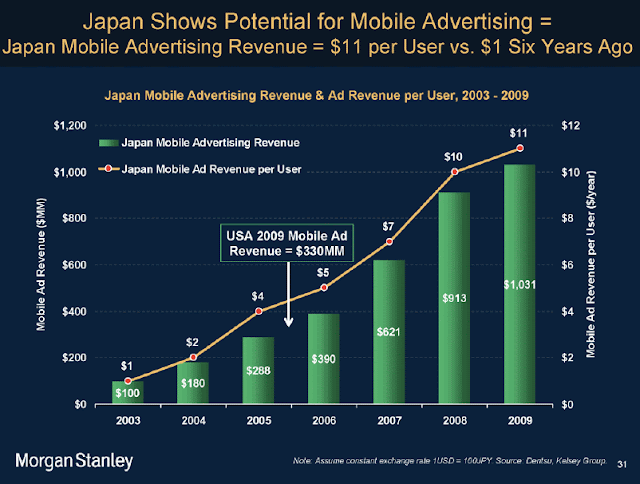
Mobile Advertising Revenue Growth in Japan
People with smartphones are still using tablets at a higher rate. Those in the states 17% are among the most likely, followed by Japan at 11%, along with United Kingdom at 10%, according to Google. The data tablet appears to fall into line with AdWords tools allowing marketers to add Mobile ad targeting. Google additionally applied the ability to target by mobile operating system in AdWords in 2011.
A research which Google conducted in two phases during 2011, in January and February followed by September and October -- finds consumers shifting from feature phones or smartphones for Internet access. In fact, they use smartphones a lot more than PC or laptop computers in the US, UK, Germany, France, and Japan. Germany had the greatest increase in smart phone owners using their device for daily Internet access, jumping from 39% to 49%. Japan had the greatest percentage surfing the Internet daily on their smartphone, at 88%. A little more than two-thirds of smart phone users in the US and more than half of smartphone users in the UK access the mobile Internet daily.
Research company eMarketer estimated mobile ad spend in the US reached $1.4 billion in 2011, up 89% from $769 billion in 2010. By the end of 2012, US mobile ad spending is estimated to grow 80% to $2.6 billion. Despite the influx of smart phones a big selection of prestigious brands are slow to pick up on a comprehensive mobile offering, according to the US L2 prestige 100 report, out of the one hundred iconic brands surveyed 33% of brands do not have a mobile app and no mobile site and only 52% have invested in a app and mobile site.
As more people increase usage of smartphones and tablets, marketers look to learn more on which mobile ads impact purchases? A mobile study of 1300 respondents conducted between Dec. 26, 2011 and Jan. 11, 2012 from digital marketing company InsightExpress sheds light on ad recall and perception. Men ages 18 to 29 are more likely to become aware of having seen mobile ads, will be more positive toward them, and are more prone to consider them new and different in comparison with traditional and digital ads. Of the men who took part in the study, 32% said they use their mobiles versus a computer Internet connection or walking into a store more often when purchasing items, when compared with 12% of women in the same age group. Men are more likely to search for an item on mobile. About 65% looked for a product in a nearby store using their phone.
Typically, young men use mobile more for information-gathering than women. While 59% of men use their mobiles to find better prices on items, 49% use their mobile to search for an item to find reviews, and 41% use their mobile phone to take a picture or send it to someone.
It can pose the question who will dominate the space moving forward and will the level of integration be considered? Feel free to share your thoughts.
No comments:
Post a Comment